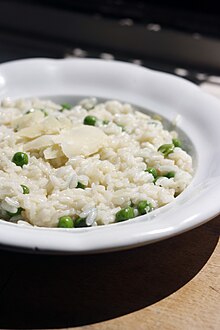Risotto



Risotto (plural: risotti) is a typical Italian dish based on rice. Originally it comes from Piedmont, where rice is commonly grown. It is very important for the cuisine of Milan. Common ingredients of the base recipe are white wine, and onions.
Risotto is a class of Italian rice dishes cooked in broth to a creamy consistency. The broth may be meat-, fish-, or vegetable-based. Many types of risotto contain Parmesan cheese, butter, and onion. It is one of the most common ways of cooking rice in Italy.
Risotto is normally a primo (first course), served on its own before the main course, but risotto alla milanese is often served together with ossobuco alla milanese.
Rice varieties
[change | change source]A high-starch (amylopectin), low-amylose round medium- or short-grain rice is usually used to make risotto. Such rices have the ability to absorb liquids and to release starch and so they are stickier than the long grain varieties.
The principal varieties used in Italy are Arborio, Baldo, Carnaroli, Maratelli, Padano, Roma, and Vialone Nano.[1] Carnaroli, Maratelli and Vialone Nano are considered to be the best (and most expensive) varieties, with different users preferring one over the other. They have slightly different properties. For example, Carnaroli is less likely than Vialone Nano to get overcooked, but the latter, being smaller, cooks faster and absorbs condiments better. Other varieties like Roma, Baldo, Ribe and Originario may be used but will not have the creaminess of the traditional dish. These varieties are considered better for soups and other non-risotto rice dishes and for making sweet rice desserts. Rice designations of Superfino, Semifino and Fino refer to the size and shape (specifically the length and the narrowness) of the grains, and not the quality.
Basic preparation
[change | change source]There are many different risotto recipes with different ingredients, but they are all based on rice of an appropriate variety cooked in a standard procedure.

The rice is first cooked briefly in a soffritto of onion and butter or olive oil to coat each grain in a film of fat, this is called tostatura; white or red wine is added and has to be absorbed by the grains. When it has evaporated, the heat is raised to medium high and very hot stock is gradually added in small amounts while stirring gently, almost constantly: stirring loosens the starch molecules from the outside of the rice grains into the surrounding liquid, creating a smooth creamy-textured liquid. At that point it is taken off the heat for the mantecatura when diced cold butter and finely grated Parmigiano-Reggiano cheese are vigorously stirred in to make the texture as creamy and smooth as possible. It may be removed from the heat a few minutes earlier, and left to cook with its residual heat. Seafood risotti generally do not include cheese.
Properly cooked risotto is rich and creamy but still with some resistance or bite: al dente, and with separate grains. The traditional texture is fairly fluid, or all'onda ("wavy, or flowing in waves"). It is served on flat dishes and it should easily spread out but not have excess watery liquid around the perimeter. It must be eaten at once as it continues to cook in its own heat and can become too dry with the grains too soft.
Variations
[change | change source]
Risotto can be made using many kinds of vegetable, meat, fish, seafood and legumes, and different types of wine and cheese may be used. There is even, exceptionally, an Italian strawberry risotto.
Many variations have their own names:
- Risotto alla milanese. Made with beef stock, beef bone marrow, lard (instead of butter) and cheese, flavored and colored with saffron.
- Piedmont's risotto al Barolo is made with red wine and may include sausage meat and or Borlotti beans.
- Black risotto or risotto al nero di seppia made with cuttlefish cooked with their ink-sacs intact, is a specialty of the Veneto region.
- Risi e Bisi[2] or "rice and peas" is a Veneto spring dish that is correctly served with a spoon not a fork; it is a soup so thick it looks like a risotto. It is made with green peas using the stock from the fresh young pods, flavored with Pancetta.
Notes
[change | change source]- ↑ Green, Aliza (2006). Starting with Ingredients. Running Press. p. 810. ISBN 978-0-7624-2747-5. Archived from the original on 2014-06-28. Retrieved 2017-08-31.
- ↑ "Carmelita's Cookitaly - Filed under 'Peas'". Archived from the original on 2013-05-26. Retrieved 2012-11-05.
References
[change | change source]- Barrett, Judith, and Wasserman, Norma (1987). Risotto. New York: Scribner. ISBN 0-02-030395-5.
- Hazan, Marcella (1992). Essentials of Classic Italian Cooking. New York: Alfred A. Knopf. ISBN 0-394-58404-X.
Other websites
[change | change source]- Free Culinary School Podcast Episode 4 A podcast episode that talks about the classical technique and science behind making risotto.
- How to make Risotto Step-by-step instructions on how to make a perfect risotto.
- Shrimp Risotto Recipe Archived 2013-05-14 at the Wayback Machine Recipe to make heart-healthy risotto.
